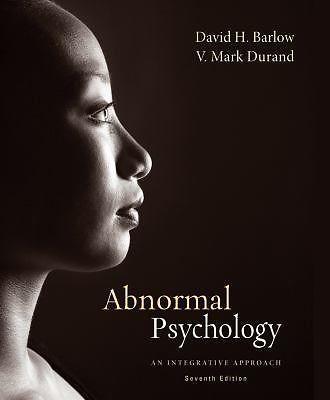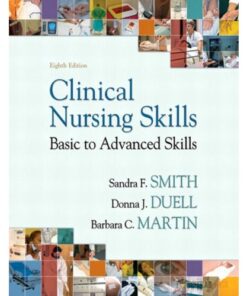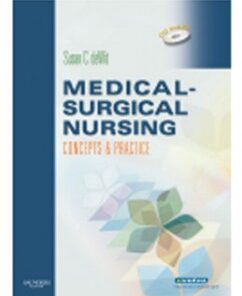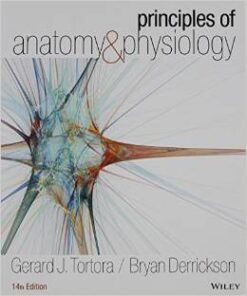Abnormal Psychology An Integrative Approach Barlow 7th Edition Test Bank
$35.00
Abnormal Psychology An Integrative Approach Barlow 7th Edition Test Bank
You will receive this product immediate after placing the order
Abnormal Psychology An Integrative Approach Barlow 7th Edition Test Bank
Abnormal Psychology An Integrative Approach Barlow Durand 7th Edition Test Bank
*** YOU ARE BUYING the Test Bank ***
Name: Abnormal Psychology An Integrative Approach
Author: Barlow Durand
Edition: 7th
ISBN-10: 1285755618
Type: Test Bank
– there’s a very high chance that you will see a very similar, if not exact the exact, question in the test!
– .doc, .padf, excel, or zipped in the package and can easily be read on PCs and Macs.
– Delivery is INSTANT. IMMEDIATELY once payment is done.
If you have any questions, please feel free to contact us. Our response is the fastest. All questions will always be answered in 6 hours., most of the time within 30mins
We also faced similar difficulities when we were students, and we understand how you feel.
But now, with the Abnormal Psychology An Integrative Approach Test Bank, you will be able to
* Anticipate the type of the questions that will appear in your exam.
* Reduces the hassle and stress of your student life.
* Improve your studying and also get a better grade!
* Get prepared for examination questions.
*Can save you time and help you understand the material.
This is the quality of service we are providing and we hope to be your helper.
Test Bank is accurate.
Prepare to receive your Abnormal Psychology An Integrative Approach Test Bank in the next moment.
If you have any questions, or would like a receive a sample chapter before your purchase, please contact us at [email protected]
Abnormal Psychology An Integrative Approach Test Bank
Abnormal Psychology An Integrative Approach Barlow Durand 7th Edition Test Bank ISBN: 1285755618
1. According to the authors of your textbook, the definition of a psychological disorder is associated with
___________.
a. stress b. impaired functioning
c. culturally expected responses d. psychotic symptoms
ANSWER: b
POINTS: 1
DIFFICULTY: Easy
REFERENCES: Understanding Psychopathology
OTHER: TYPE: Factual
2. Regarding the criteria that define abnormality, it would be correct to state that
a. no one criterion has yet been developed that fully defines abnormality.
b. personal distress is the one criterion that defines abnormality.
c. the criteria differ depending on the cause of the psychological disorder.
d. the criteria differ depending on whether the individual has a psychological disorder or a psychological
dysfunction.
ANSWER: a
POINTS: 1
DIFFICULTY: Moderate
REFERENCES: Understanding Psychopathology
OTHER: TYPE: Conceptual
3. The criterion that a particular behavior be atypical or not culturally expected is insufficient to define abnormality
because
a. behavior that occurs infrequently is considered abnormal in every culture.
b. society is less willing to tolerate eccentricity in people who are productive.
c. behaviors vary very little from one culture to another.
d. many people behave in ways that deviate from the average, but this doesn’t mean that they have a disorder.
ANSWER: d
POINTS: 1
DIFFICULTY: Difficult
REFERENCES: Understanding Psychopathology
OTHER: TYPE: Conceptual
4. A psychological dysfunction refers to
a. a breakdown in cognitive functioning. b. a breakdown in emotional functioning.
c. a breakdown in behavioral functioning. d. any one or combination of the above
ANSWER: d
POINTS: 1
DIFFICULTY: Moderate
REFERENCES: Understanding Psychopathology
OTHER: TYPE: Factual
5. Behaviors that deviate from the norm are
a. always seen as a disorder if they violate social norms.
b. considered a disorder regardless of culture.
c. typically seen as a disorder when they impair function.
d. never judged on the basis of the person who does them.
ANSWER: c
POINTS: 1
DIFFICULTY: Difficult
REFERENCES: Understanding Psychopathology
OTHER: TYPE: Conceptual
6. A male college student begins feeling sad and lonely. Although still able to go to classes and work at his job, he
finds himself feeling down much of the time and worrying about what is happening to him. Which part of the
definition of abnormality applies to his situation?
a. Personal distress b. Cultural factors
c. Impaired functioning d. Violation of societal norms
ANSWER: a
POINTS: 1
DIFFICULTY: Moderate
REFERENCES: Understanding Psychopathology
OTHER: TYPE: Applied
7. The typical profile or prototype of a disorder reflects the ___________ as described in DSM-IV as well as those
emerging from DSM-5.
a. theoretical perspectives on abnormality
b. treatments for mental disorders
c. causes of mental illness
d. diagnostic criteria for psychological disorders
ANSWER: d
POINTS: 1
DIFFICULTY: Moderate
REFERENCES: Understanding Psychopathology
OTHER: TYPE: Conceptual
8. Rocky Starr is a rocker who wears outlandish female makeup and women’s clothing when performing on stage.
This behavior is considered
a. more abnormal than that of a business man who suddenly starts to do so.
b. less abnormal than that of the business man because it contributes to his job success.
c. less abnormal than that of a female who wears makeup every day.
d. just as abnormal as that of the business man who starts wearing makeup.
ANSWER: b
POINTS: 1
DIFFICULTY: Moderate
REFERENCES: Understanding Psychopathology
OTHER: TYPE: Applied
9. The scientific study of psychological disorders is called __________.
a. psychopathology b. psychoanalysis
c. pseudoscience d. parapsychology
ANSWER: a
POINTS: 1
DIFFICULTY: Easy
REFERENCES: Understanding Psychopathology
OTHER: TYPE: Factual
10. After college graduation, two of your friends are interested in careers in the helping professions. Anna wants to
become a psychiatrist; Carl plans on becoming a psychologist. Since you are taking a course in Abnormal
Psychology, they ask you for career advice. You would tell
a. Anna to apply to medical school and Carl to study psychology at the graduate level.
b. Carl to apply to medical school and Anna to study psychology at the graduate level.
c. both of them to apply to medical school.
d. both of them to apply to graduate school.
ANSWER: a
POINTS: 1
DIFFICULTY: Moderate
REFERENCES: Understanding Psychopathology
OTHER: TYPE: Applied
11. Dr. Okalemi Watabe is a mental health practioner. All of the following are ways in which she might function as a
scientist-practitioner EXCEPT
a. analyzing her own motivations and reasons for helping people with psychological problems.
b. evaluating her own assessments and treatments for effectiveness.
c. conducting research leading to new information about mental disorders and their treatments.
d. using the most current diagnostic and treatment procedures.
ANSWER: a
POINTS: 1
DIFFICULTY: Difficult
REFERENCES: Understanding Psychopathology
OTHER: TYPE: Applied
12. A ___________ is what first brought the individual to therapy; the ____________ represents the unique
combination of behaviors, thoughts, and feelings that make up a specific disorder.
a. diagnosis; symptoms b. incidence, prevalence
c. clinical description; presenting problem d. presenting problem; clinical description
ANSWER: d
POINTS: 1
DIFFICULTY: Moderate
REFERENCES: Understanding Psychopathology
OTHER: TYPE: Conceptual
13. Prevalence refers to
a. how many people in the population as a whole have a particular disorder.
b. how many new cases of a disorder occur during a given period of time.
c. the percentage of males and females who have a disorder.
d. how many people have recovered from a disorder in a given period of time.
ANSWER: a
POINTS: 1
DIFFICULTY: Easy
REFERENCES: Understanding Psychopathology
OTHER: TYPE: Factual
14. Incidence refers to
a. how many people in the population as a whole have a disorder.
b. how many new cases of a disorder occur during a given period of time.
c. the percentage of males and females who have a disorder.
d. how many people have recovered from a disorder in a given period of time.
ANSWER: b
POINTS: 1
DIFFICULTY: Moderate
REFERENCES: Understanding Psychopathology
OTHER: TYPE: Factual
15. Statistical data are often relevant when discussing psychological disorders. For example, a researcher might want to
know how many new cases of depression are diagnosed each year, a figure called the ___________ of the
disorder.
a. prevalence b. incidence
c. recurrence d. ratio
ANSWER: b
POINTS: 1
DIFFICULTY: Moderate
REFERENCES: Understanding Psychopathology
OTHER: TYPE: Conceptual
16. In terms of their typical patterns, schizophrenia follows a chroniccourse, while mood disorders, including
depression, follow a(n) _____________ course.
a. episodic b. time-limited
c. guarded d. insidious
ANSWER: a
POINTS: 1
DIFFICULTY: Moderate
REFERENCES: Understanding Psychopathology
OTHER: TYPE: Conceptual
17. A psychological disorder is described as having an acute onset if the symptoms develop __________, while it has
an insidious onset if the symptoms develop __________ .
a. suddenly; gradually b. suddenly; atypically
c. gradually; atypically d. atypically; suddenly
ANSWER: a
POINTS: 1
DIFFICULTY: Moderate
REFERENCES: Understanding Psychopathology
OTHER: TYPE: Conceptual
18. A disorder that comes on slowly is said to have a(n) _______ onset.
a. acute b. chronic
c. insidious d. overt
ANSWER: c
POINTS: 1
DIFFICULTY: Easy
REFERENCES: Understanding Psychopathology
OTHER: TYPE: Factual
19. When Larry was diagnosed with schizophrenia, his family wanted to know how the disorder would affect him and
how it would progress. In medical terms, they wanted to know Larry’s _______.
a. diagnosis b. prognosis
c. psychosocial profile d. pathology
ANSWER: b
POINTS: 1
DIFFICULTY: Moderate
REFERENCES: Understanding Psychopathology
OTHER: TYPE: Applied
20. Developmental psychopathology refers to the study of changes in
a. abnormal behavior.
b. normal behavior.
c. children’s behavior, both normal and abnormal.
d. normal adolescent behavior.
ANSWER: a
POINTS: 1
DIFFICULTY: Easy
REFERENCES: Understanding Psychopathology
OTHER: TYPE: Factual
21. Dr. Littlefox studies the origins and causes of psychological disorders, including the biological, psychological, and
social dimensions. Dr. Littlefox studies the ___________ of a disorder.
a. prognosis b. etiology
c. outcome d. psychopathology
ANSWER: b
POINTS: 1
DIFFICULTY: Moderate
REFERENCES: Understanding Psychopathology
OTHER: TYPE: Applied
22. At various times in history, in an attempt to explain problematic, irrational behavior, humans have focused on
supernatural causes that include all of the following EXCEPT
a. magnetic fields. b. demons and evil spirits.
c. bodily humors. d. the moon and stars.
ANSWER: c
POINTS: 1
DIFFICULTY: Moderate
REFERENCES: Understanding Psychopathology
OTHER: TYPE: Conceptual
23. The biological and psychological models or theories of abnormality derived originally from the ancient Greek
concept in which the
a. mind was considered separate from the body.
b. flow of bodily fluids affected behavior and personality.
c. female reproductive organs were associated with psychopathology.
d. movement of the planets influenced human behavior.
ANSWER: a
POINTS: 1
DIFFICULTY: Difficult
REFERENCES: Understanding Psychopathology
OTHER: TYPE: Conceptual
24. Since the time of ancient Greece, the concept of a psyche or soul was similar to that of the _______.
a. brain b. mind
c. body d. blood
ANSWER: b
POINTS: 1
DIFFICULTY: Easy
REFERENCES: Understanding Psychopathology
OTHER: TYPE: Conceptual
25. Toward the end of the 14th century and continuing into the 15th century, the causes of “madness” were generally
attributed to
a. toxins in the blood. b. religious delusions.
c. brain disease. d. demons and witches.
ANSWER: d
POINTS: 1
DIFFICULTY: Moderate
REFERENCES: The Supernatural Tradition
OTHER: TYPE: Conceptual
26. Which of the following accurately describes common beliefs about people with psychological disorders during the
14th century?
a. They were considered to be suffering from religious delusions and were cared for by members of the church
communities.
b. They were seen as possessed by evil spirits and blamed for all misfortunes.
c. They were regarded as basically good individuals who were not responsible for their abnormal behavior.
d. They were provided with medical treatments and sometimes hospitalized because mental illness was
regarded as equivalent to physical illness.
ANSWER: b
POINTS: 1
DIFFICULTY: Moderate
REFERENCES: The Supernatural Tradition
OTHER: TYPE: Conceptual
27. During the Middle Ages, as well as at other times, mentally ill people were sometimes forced to undergo the
religious ritual called exorcism in order to
a. cure the mental illness by making the individual more religious.
b. build up muscle strength and make the person healthier.
c. rid the individual’s body of evil spirits.
d. prove that the person was not a witch.
ANSWER: c
POINTS: 1
DIFFICULTY: Easy
REFERENCES: The Supernatural Tradition
OTHER: TYPE: Factual
28. The treatment given to the mentally ill King Charles VI of France showed that the causes of his disorder were
attributed to ______________ phenomena.
a. natural b. supernatural
c. both natural and supernatural d. neither natural nor supernatural
ANSWER: c
POINTS: 1
DIFFICULTY: Difficult
REFERENCES: The Supernatural Tradition
OTHER: TYPE: Applied
29. In keeping with an accepted treatment for mental illness in the 14th century, a physician treating King Charles VI
of France had him moved to the countryside in order to
a. be closer to a hospital that treated mental illness.
b. keep him away from his family.
c. provide clean air, rest, relaxation, and recreation.
d. cure him of hysteria.
ANSWER: c
POINTS: 1
DIFFICULTY: Difficult
REFERENCES: The Biological Perspective
OTHER: TYPE: Applied
30. The belief of homophobic people that the “sin” of homosexuality has resulted in HIV/AIDS is related to the
historical concept of ______________ as a cause of madness.
a. divine punishment b. faith healing
c. hysteria d. sorcery
ANSWER: a
POINTS: 1
DIFFICULTY: Moderate
REFERENCES: The Supernatural Tradition
OTHER: TYPE: Applied












Reviews
There are no reviews yet.